It is very easy to find a huge amount of Dominican Fruits of all varieties and flavors when visiting this beautiful tropical Island. They grow and ripen in all corners of the Dominican Republic, from the tropical forests and gardens to the trees on the street sidewalks.
Besides their extremely tasty and diversified flavors, these fruits bring tremendous health benefits and healthy nutrients. For this reason, they are involved in various smoothies, drinks, and famous dishes in Dominica.
This post will compile the tastiest and healthy fruits you can find in the Dominican Republic, along with their health benefits. You can learn to make exotic foods and drinks using these fruits and add more flavors to your life based on the information provided.
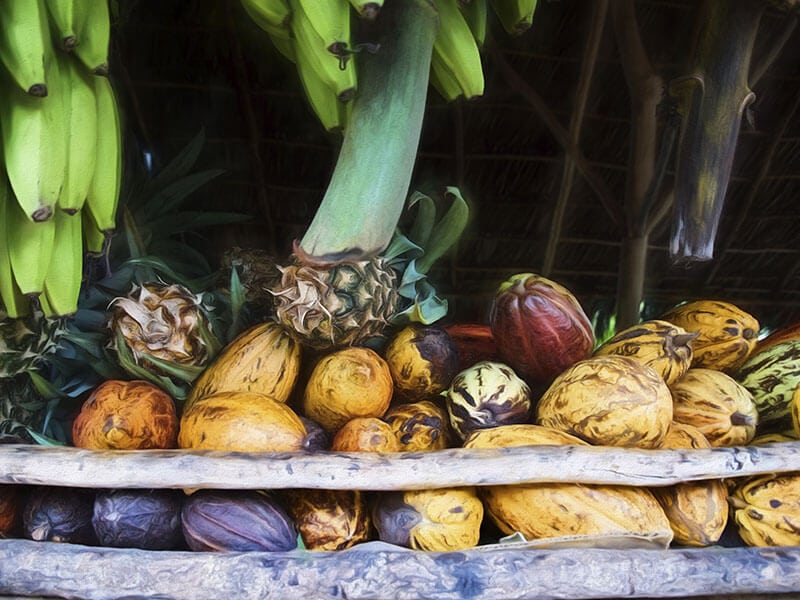
14 Incredibly Tasty Dominican Fruits With Bright Colors To Light Up Your Day
It’s hard to find things with exotic colors in nature, but the fruits are a rare exception. The fruits in this section come in bright colors, ranging from pale yellow and golden yellow to reddish-orange when they ripe.
Just looking at them can instantly brighten up your mood and add more optimism to the day. These fruits come in different crop seasons and feature distinct flavors and characteristics. Some are the ingredients for the classic Dominican beverages.
This list will give you a hint of their nutrients, traits, and the best way to serve these fruits to retain their original flavors. No further talking. Let’s jump straight to the most exotic Dominican fruits with seeds!
1. Buen Pan/Pan De Fruita (Breadfruit)
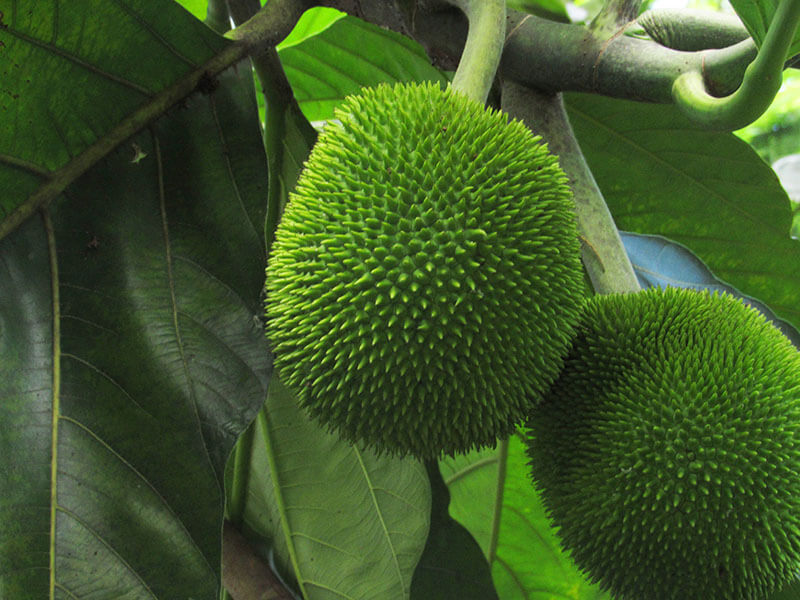
As its name suggests, Buen Pan or breadfruit has a pup texture similar to baked potato or bread. Breadfruit can come in a large oval or round shape with around 30 inches in diameter and 2 to 4 kilograms in weight. (about the size of a football).
Buen Pan is a cultivated fruit grown in every agricultural zone in the Dominican Republic. It reaches the finest texture and flavor when ripened. Buen Pan flesh gives a starchy and savory flavor with a typical white pale to yellow texture.
Buen Pan is a popular ingredient for making curries, soups, and meat-based dishes in the Dominican Republic. They also mix the fresh and cold Buen Pan flesh in a salad or with a mixture of dairy and nuts to make a delicious and refreshing drink.
Nutrients: Buen Pan contains a rich source of proteins, vitamins, omega acids, and antioxidants.
Season: In Hawaii, breadfruit season happens between July to February. Meanwhile, the seeded breadfruit seasons occur between December and March on the Eastern Caroline Islands.
How to eat: To consume the fresh unripe Buen Pan fruit, you first have to crack it open with a sharp knife and cook the fresh flesh. You can either steam, fry, boil or bake the flesh to serve. The dark Buen Pan seeds are also edible, so there’s no need to discard them.
Meanwhile, the ripe Buen Pan flesh can be eaten raw without cooking. You can find the cocktails and soft drinks that involve Buen Pan.
2. Mandarina (Mandarins)
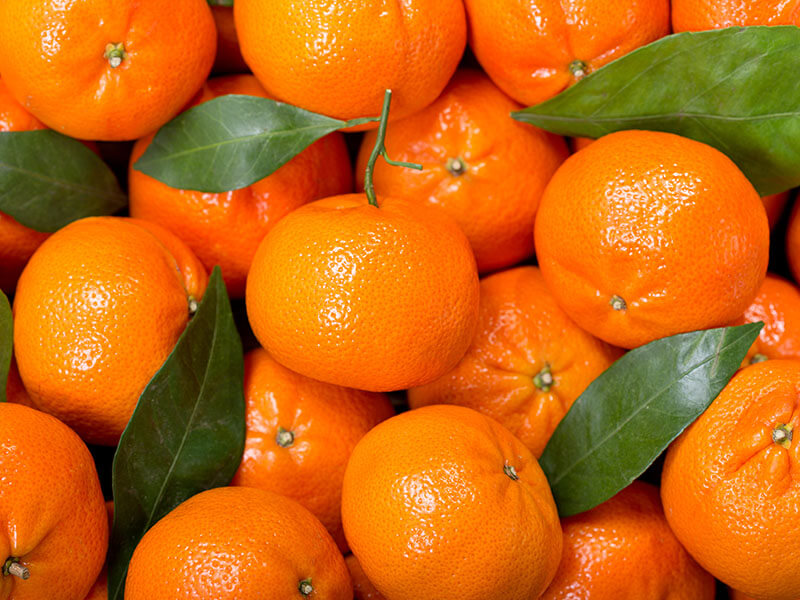
Mandarin oranges or Citrus reticulata are smaller than the common oranges in America. This fruit is among the most popular orange fruits in the Dominican Republic. On Christmas, the Dominicans often make the Licor De Mandarina, or mandarin orange liqueur, to celebrate.
Like the other types of oranges, Mandarina features a similar fruity taste but with sweeter and juicier pulp, along with the thicker skin. Ripen mandarins are very soft and heavy for their sizes, with an attractive bright orange color.
Mandarina is an ideal fruit for those who love eating fresh and raw fruits as a snack. Its skin is very easy to peel. Depending on the variety, a Mandarina can be seedless or contain some seeds.
Its peel also delivers a heart-lightening aroma, which can be used for cooking to enhance the scent and flavors of the dishes. The oil from Mandarina peel is also a flavor for producing chewing gums, ice cream, and candies.
Nutrients: Mandarin contains mostly water, carbohydrates, and a small proportion of protein and fat, along with other micronutrients like vitamin C.
Season: Mandarins grow in the months with a cooler climate, most likely from November through April.
How to eat: The best way to consume Mandarina is to peel its skins and eat the fresh ripened pulp or squeeze it to make juice. You can also mix Mandarina pulp in salads, main dishes, or desserts.
3. Genipa (Jagua)
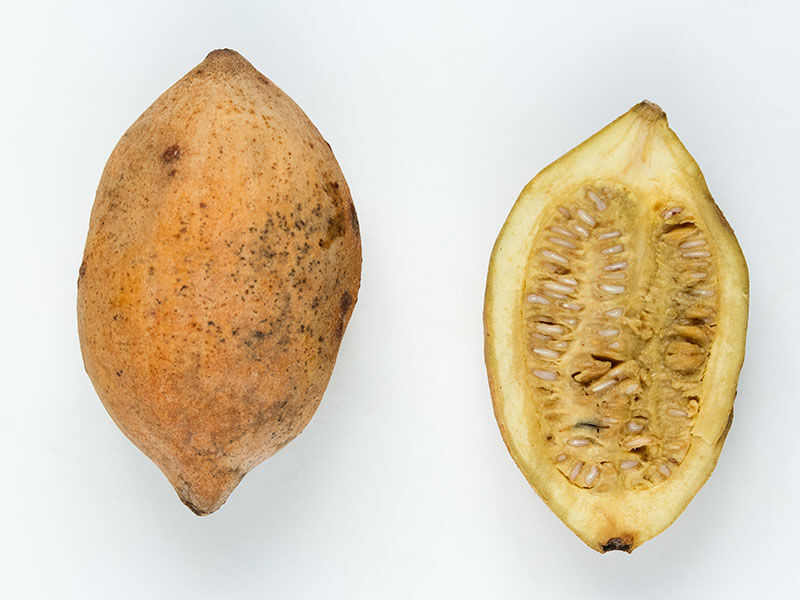
Jagua is also known as Genipa Americana, a prevalent tropical fruit in the Dominican Republic. The Jagua possesses a tiny to medium size with a diameter of around 4 to 11 centimeters.
This fruit is recognizable due to its distinctive grayish-green skin color and crown-shaped tip. Jagua will turn yellow when it gets ripe with a pretty dry surface. People used to consider Jagua a sacred fruit in the past.
They believe this fruit bears the mother of the first woman on Earth. Jagua pulp has an attractive yellow color with numerous seeds when it turns ripe. It contains medicinal properties that are beneficial for dropsy and chronic enteritis.
In the Dominican, the unripe Jagua is used as a bluish-black dye for dying utensils and clothes. You can also toast the green Jagua and rub it on the skin to ward off insects and mosquitoes. This fruit is also a staple ingredient for the famous Guarapo de Jagua drink in the Dominican.
Nutrients: Jagua is a rich source of natural iron, anti-bacterial compounds, and riboflavin with many essential vitamins like vitamins B, calcium, and phosphorus.
Season: In Puerto Rico, the Jagua trees bear flowers and fruits from spring to fall. Meanwhile, in Brazil, the flowers appear in November, and the fruits are available between February and March.
How to eat: You can eat the fresh and ripe Jagua or use it to make jams, liqueurs, and drinks such as the Guarapo de Jagua.
4. Cajuil (Cashew Apple)
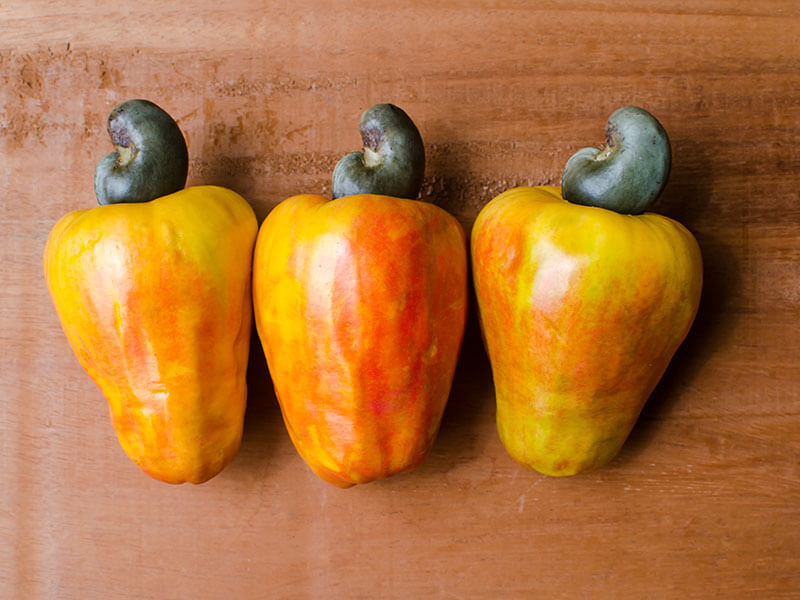
Cajuil or cashew apple is the staple ingredient for a famous jam called Dulce de Cajuil in the Dominican Republic. Its shape and size are quite similar to a pear but commonly come in red or yellow color and waxy skin.
Cajuil pulp delivers a sweet and juicy flavor with a rather dry texture. While this fruit used to be considered a waste, now it is a staple ingredient for making all types of culinary, sweet treats, and beverages.
Cajuil is commercially cultivated in many tropical regions. It brings tremendous benefits as many people eat Cajuil to cure sore throat and dysentery. This exotic fruit is growing in popularity every year in the Dominican Republic.
Nutrients: Cashew apple is an abundant source of fiber, iron, calcium, and phosphorus, with five-time the amount of vitamin C in an orange.
Season: The Cajuil trees in the Northern hemisphere bear flowers between June and December, while in the Southern hemisphere, the season takes place from September to November. The trees will bear fruit one week after fertilization.
How to eat: If you are visiting a cashew garden, the ripe fruit can be picked straight off the tree to consume fresh. However, 90% of cashew is used for making alcoholic drinks, dishes, and sweet treats like the Dulce de Cajuil in the Dominican Republic, for example.
What is so special about the Cashew apple’s weird flavor and texture? This guide will tell you.
5. Manzana De Oro (Ambarella)
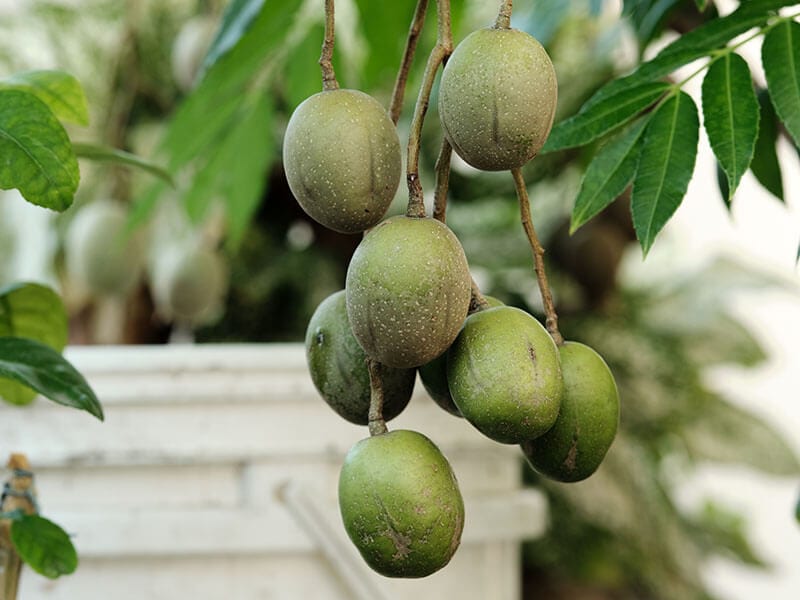
Ambarella is an edible and fibrous fruit commonly known as Pommecythere or Manzana de Oro in tropical areas and the golden apple in English. Ambarella trees thrive in humid and tropical jungles that can grow up to 10-12 meters in height.
A typical ambarella fruit ranges around 6 to 9 centimeters in size with an oval shape. While the other fruits mature and ripen on the branches, ambarella fruits fall to the ground when they are still hard and green. After several weeks, the fruits ripen and turn yellow.
Inside the beautiful yellow skin is a sweet and juicy pulp with an acidity hint. Manzana de Ora features a blend of crunchy and mild sour taste, even when it perfectly ripens. Its flavor has similar traits to the taste of mango and pineapple.
Nutrients: Ambarella contains carbohydrates, energy, protein, and many healthy micronutrients, such as vitamin A/B, calcium, iron, and phosphorous.
Season: Manzana de Oro fruits are available from fall through summer.
How to eat: You can eat both raw or ripe Ambarella fruit pulp. It appears in many countries’ culinary cultures as a preserve or seasoning for various dishes, commonly soups, brews, and stews.
In addition, Ambarella can be made into drinks mixed with sugar and ginger. The tender Ambralla leaves are also edible as a salad cuisine or side dish.
6. Jobo (Hog Plums)
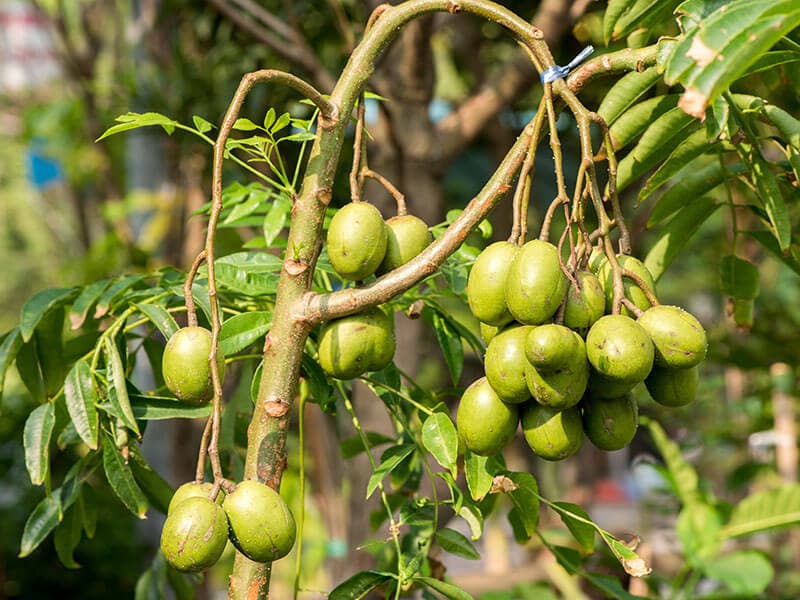
Unlike the common fruits sold on any market, Jobo, or hog plums, is an exotic fruit that is difficult to find, even in the tropical islands where it grows. This fruit belongs to the evergreen tree family indigenous to tropical America and West Indies.
Jobo fruits are very tiny, commonly around 2 to 4 centimeters in size. They have a rounded shape with a vibrant orange or yellow color when they ripen. Their skin is leathery while the flesh is quite thin, surrounding a single spiny kernel.
The fruits can be eaten fresh or used to make juice, but their taste is slightly sour and bitter with a sharp, acidic undertone. All the Jobo tree components are applicable for medicinal uses.
Its leaves and barks act as febrifuge and diuretic. The Jobo fruit can be rubbed directly on the skin to treat inflammation and gum infection. Meanwhile, the Jobos leaves are infused to treat diarrhea, venereal diseases, and pain.
Nutrients: Jobo contains a considerable proportion of carotenoids (pro-vitamin A), along with other essential nutrients like protein, carbohydrate, fat, and dietary fiber.
Season: Jobo flowers appear between January and May, followed by fruits from July to September.
How to eat: You can either peel the skin to eat the fresh Jobo pulp or make it into concentrate, juice, and jellies. In Thai cuisine, the Jobo leaves are served raw with chili pastes, while in Bangladesh, people serve it with chili powder.
7. Zapote (Mamey Sapote)
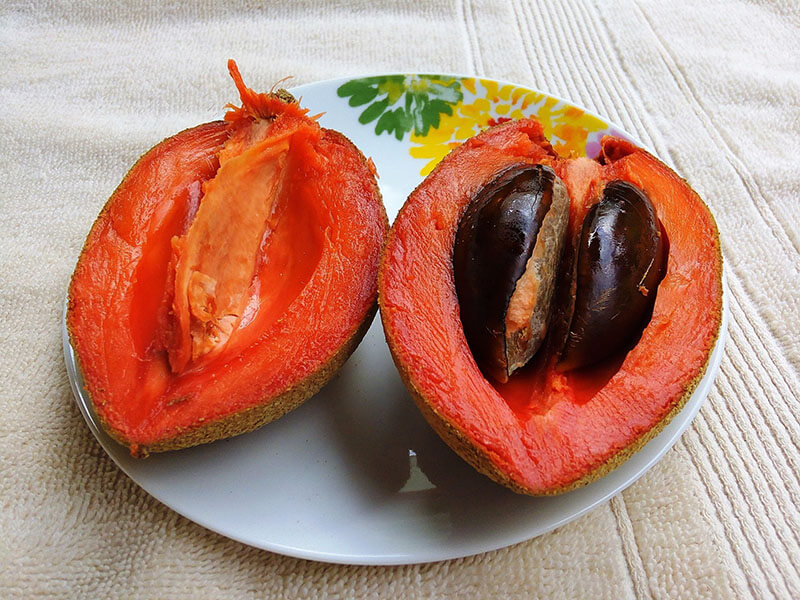
Zapote or Sapote is one of the most recognizable Dominican fruits. It grows on the Zapote trees, which can reach more than 20 meters in height. The sapotes feature a long size with a classic dark brown or orange color.
There are multiple variations of the sapote fruits like quite sapote, Mamey sapote, or Sapodilla. They may have slightly distinct flavors but have generally soft and edible flesh. Mamey fruit typically comes in a small oval shape, which is quite similar to a mini football.
This fruit brings a mild sweetness and pleasant flavor with a pumpkin-like and nutty undertone. The most popular type of Zapote in the Dominican Republic is Mamey sapote. It tastes like a mixture of pumpkin and sweet potatoes.
Zapote’s flavor can be described as a cross of pumpkin, sweet potato, honey, or even cherry and almond. Its creamy and tender texture is the perfect filling base and ingredient for making smoothies or fruit shake.
Nutrients: Rich in calories, potassium, carbohydrates like fructose and glucose, dietary fiber, polyphenolic antioxidants, and vitamin C, E, and B6.
Season: The Zapote season starts from May to July or may be available all year in North America and Mexico.
How To Eat: The ripe and fresh Mamey sapote can be eaten raw or used to make ice cream, fruit shakes, smoothies, cakes, muffins, or served as the pastry filling.
The following guide contains everything you need to know about Sapote fruit!
8. Piña (Pineapple)
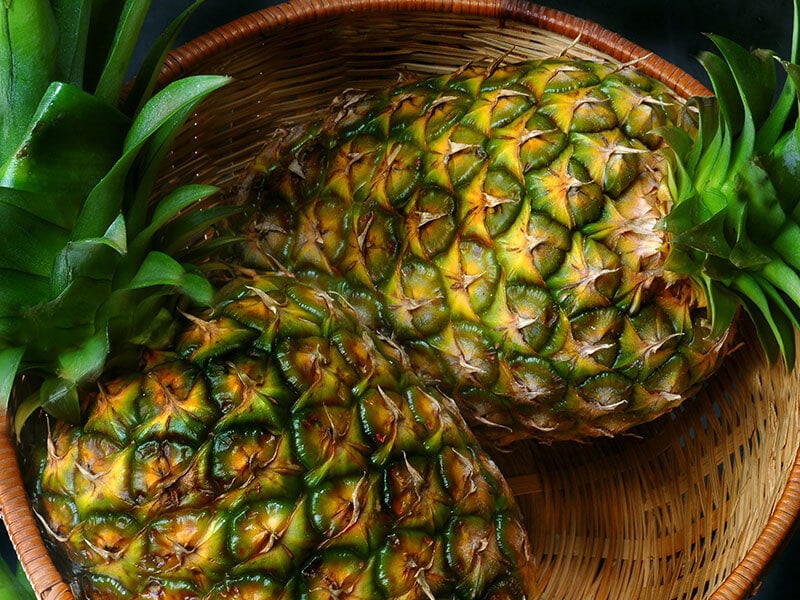
Among the most delicious and healthy tropical fruits, pineapple is an honorable example. This fruit originated in South America and has been gradually cultivated in many regions worldwide, including the Dominican Republic.
Pineapple brings great versatility as it can be used to make all kinds of cocktails, desserts, and savory foods. The fruit is a familiar ingredient in the Caribbean and Dominican cuisine, featuring a sweet and tart flavor.
It is generally cheaper than the other types of fruit, bringing a satisfying freshness to the hot summer days. To pick a fresh and high-quality pineapple, you should prioritize the heavy and plump fruits with shiny and bright skin.
Nutrients: Pineapple is packed with antioxidants, calories, fiber, carbohydrates, and many other healthy compounds.
Season: This fruit is available all year round, but you can find the most affordable and delicious pineapples between March and July.
How to eat: Ensure that the pineapple is completely ripe, as the unripe fruit is simultaneously toxic and tastes awful. You can remove the hard skin using a sharp knife and chop its cone into small slices to serve.
You can also blend fresh pineapple slices to make pineapple juice. It is also a common ingredient for many delicious desserts and jams.
9. Mango
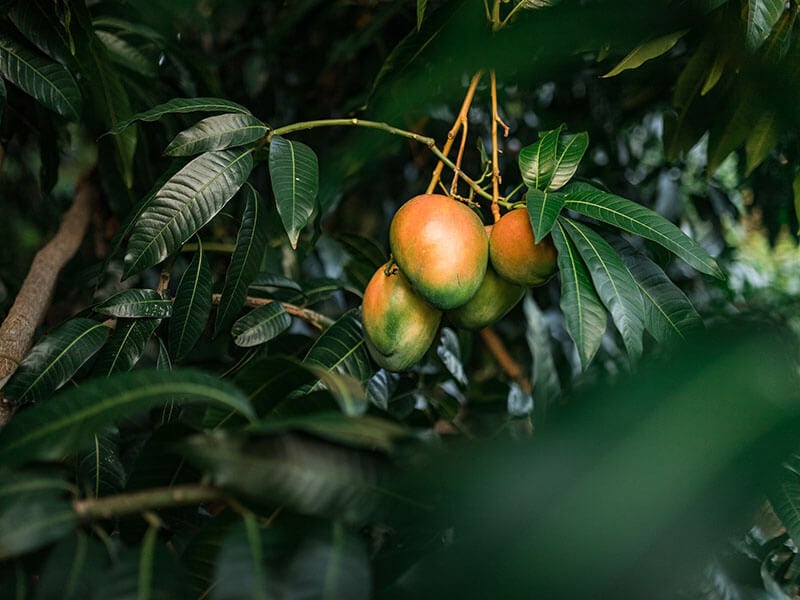
After the banana, mango is one of the most cultivated and commercialized fruits in tropical regions. Mango growth and cultivation are spread throughout the Dominican Republic’s territory. The fruit is mainly used for domestic consumption due to its tasty and familiar flavor.
Mangoes can have yellow or purple skin when they ripen with a soft and waxy texture. The ripened Mango flesh comes in orange or yellow, with a juicy and smooth texture. Dominican mango is one of the tastiest kinds, with an unmistakable sweet flavor.
It is said that every home in the Dominican Republic owns a mango tree, which can extend up to 80 feet tall. You have to wait for six years for the trees to bear the first fruit. But the filling and satisfying taste of the ripened mangoes is worth your patience.
Nutrients: Mangoes are packed with calories, protein, carbohydrates, and many vitamins (C, A, B6, E, or K).
Season: The peak mango seasons are from May through September, but the imported mangoes are available all year round. Meanwhile, the peak mango month in the Dominican Republic is June.
How to eat: The mangoes taste best when they are ripe. You can check their ripeness by pushing a finger into the fruits, and it leaves a dent in the skin. Remember to wash the mangoes’ skin thoroughly and cut the pulp into small slices or cubes to serve. You can also add mango to smoothies or other frozen desserts.
10. Cacao
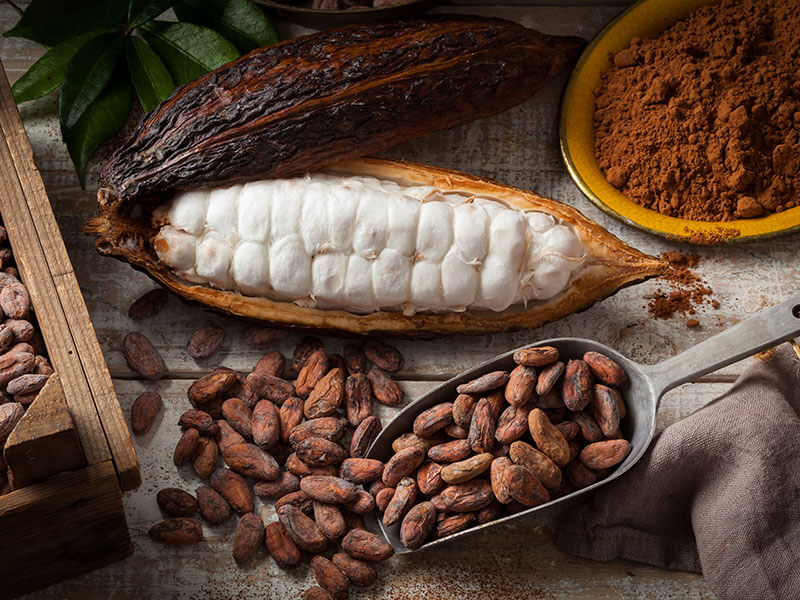
Cacao or Cocoa is a very prevalent fruit in the Dominican Republic. The Cacao trees were cultivated thousands of years ago and have become ingenious in tropical regions. The Dominican Cacao commonly has yellow skin and slight acidity.
You surely have consumed this delicious fruit through cacao drinks or chocolate cakes. It features an unmistakable flavor and gorgeous aroma. The taste of Cacao is very hearty and quite similar to chocolate, though they may vary in different regions.
Besides its excellent taste and scent, Cacao is known as a superfood that contains an abundant source of antioxidants and healthy micronutrients. It can help boost mood and energy and is very beneficial for people with cardiovascular diseases or digestive problems.
Cacao products like cacao powder and butter are prevalent in many grocery stores. Cacao powder is a staple ingredient in many chocolate products, cakes, and muffins. Meanwhile, cacao butter is used for making cosmetic products like skin cream or sun-tanning oils.
Nutrients: Cacao is an excellent source of protein, iron, magnesium, potassium, and fiber.
Season: The production of cocoa beans usually lasts from April to early November. There’s a second season that runs from April or May through September.
How to eat: Though you cannot eat the raw Cacao fruit, there are numerous ways to serve this exotic fruit. You can blend store-bought cacao powder into a smoothie to drink or use it as a sprinkle or addition to enhancing the flavors of the other dishes.
11. Carambola

The Carambola trees are indigenous to tropical regions and the Dominican Republic. When you slice the fruit in the cross-section, each slice will come in a star shape. That’s where the name star fruit came from.
This delicious fruit can be eaten raw, including the waxy skin. Carambola flesh is a bit crunchy and firm, emitting a lot of juice. Carambola is ripe when its skin turns yellow, delivering a mildly sweet flavor and sour undertone.
However, Carambola contains some toxins known as oxalic acid and Caramboxin. People with stomach problems, kidney stones, or disorders should avoid eating Carambola, which can lead to serious health symptoms or even death in severe cases.
Nutrients: 90% of Carambola is water. The remaining proportions are carbohydrates, protein, negligible fat, and a rich source of vitamin C.
Season: There are two Carambola seasons in a year. The first star fruit season starts from June to September, while the second one lasts between November and February.
How To Eat: You can wash the Carambola skin thoroughly and eat it raw. Remember to cut off the ends and remove the seeds first as they are inedible. Carambola can be served in salad and many other fresh dishes. You can drink its juice as a beverage.
This video will show you the best way to cut the most beautiful star fruit slices.
12. Papaya
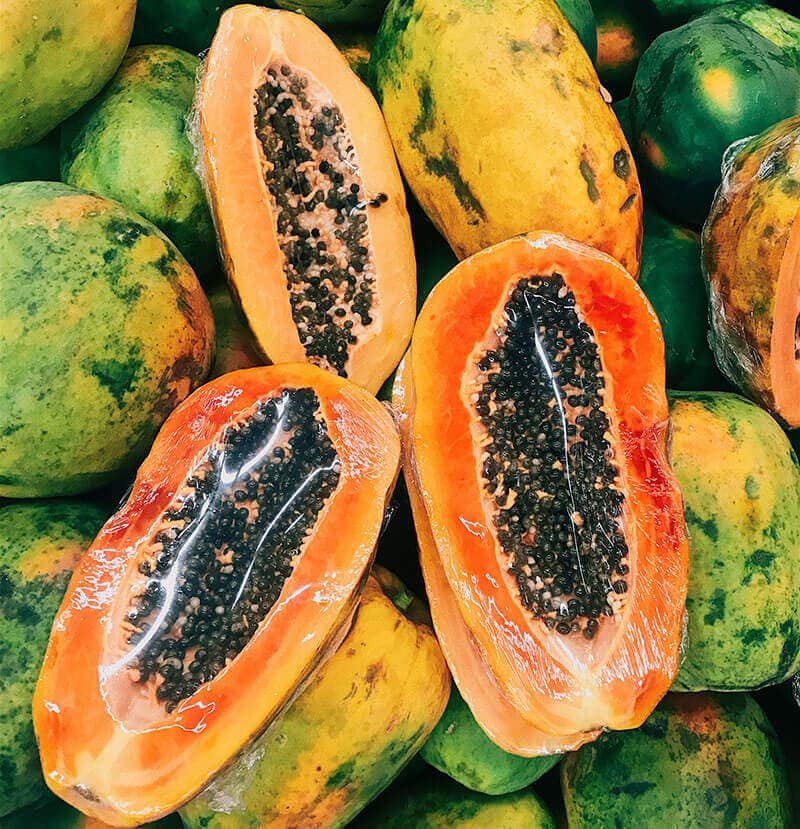
The large and shady trees in the Dominican Republic bear the exotic papaya fruits, also known as Lechosa. The papayas feature a vibrant yellow skin combined with a sweet and juicy taste, making them everyone’s favorite fruits in the tropical region.
The raw green papayas slowly turn yellow and soften as they ripen. Papaya delivers a very tasty flavor, which is quite similar to mango, but with a milder sweetness. The soft papaya flesh will melt softly in your mouth, giving a burst of fruity and refreshing taste.
Research indicates that eating papaya can reduce the risks of cancer and diabetes. It helps regulate and lower blood pressure, suitable for people suffering from cardiovascular diseases. Therefore it is very beneficial to integrate this fruit into your diet.
Nutrients: Papaya contains many calories, carbohydrates, protein, antioxidants, and other healthy nutrients.
Season: In South America, the peak papaya seasons run through early summer and fall, but the fruit is available all year long.
How to eat: Preparing the papaya is very easy. You just need to slice it in half and use the spoon to remove the seeds in the middle. The seeds are edible, but they have a bitter and unpleasant flavor. You can freeze the papaya pulp to get a more refreshing flavor.
13. Guineo (Banana)
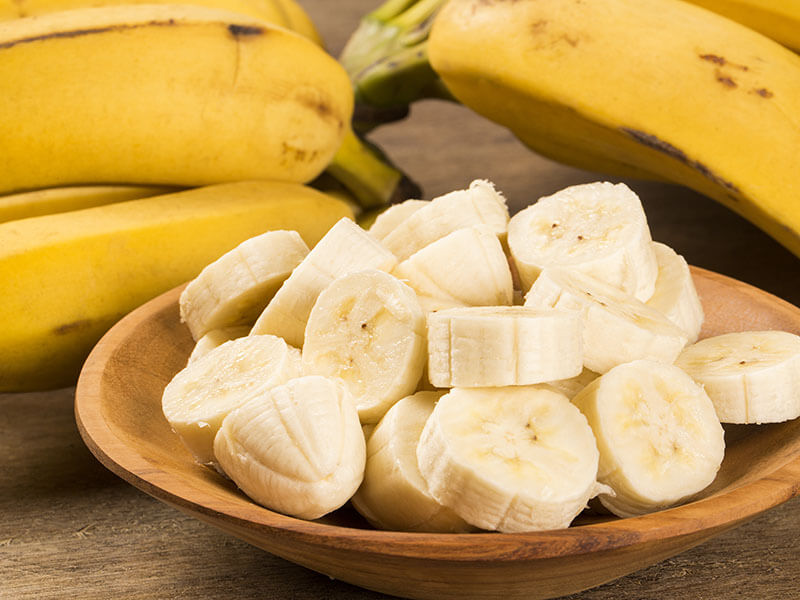
The Dominican Republic is one of the largest banana producers and exporters in the world. It’s no exaggeration to say that bananas are the most popular fruit in this country or even worldwide.
This lengthy yellow fruit can be found in grocery stores and supermarkets in all regions worldwide. Ripe bananas have a familiar yellow skin with sweet flavors. This fruit is present in our daily meals and all kinds of cuisines, desserts, and even smoothies.
Its delicious taste and soft texture can combine fabulously with any ingredients. Despite their tasty flavors and significant health benefits, bananas are much cheaper and more available than the other types of fruits.
Nutrients: Rich in calories, carbohydrates, sugar, fiber, and potassium.
Season: Banana thrives in the tropical regions and is available at any time of the year.
How to eat: Ripe bananas are a very delicious dessert. You can peel the skin from the stem end and enjoy the pulp. Another great way to eat bananas is to mix them with other fruits for smoothies.
Green banana is also the staple ingredient in the popular Dominican plantain side dish.
Do you want to know the production system of bananas in the Dominican Republic? Check this tutorial video to understand more!
14. China (Oranges)

The regular and familiar oranges are also known as China in the Dominican Republic. In the 15th century, the Crusaders and Moors brought this fruit from China, made it a familiar fruit in Portugal, and spread it to other regions. That’s the origin of this peculiar name.
In the tropical region and the Dominican Republic, the orange trees are widely cultivated for their sweet fruits. The Dominican oranges feature a typical orange skin with a sweet and pleasant flavor and a mild acid taste.
Nutrients: More than 80% of a fresh orange is water. The remaining proportions are carbohydrates, protein, and negligible fat. Oranges are also a rich source of vitamin C and phytochemicals.
Season: The time and seasons may vary for different types of oranges. The regular oranges are available all year round, but the tastiest and finest fruits appear from mid-winter to early spring.
How to eat: The sweet and ripe oranges taste good when eaten fresh. You can peel their skin by hand or slice them in half with a knife. The orange juice can be used for smoothies, drinks, and cocktails.
9 Popular Dominican Fruits With Familiar Green Color
It’s not an exaggeration to say that green is the color of nature. This familiar color appears in various natural livings and objects, from trees, forests, and plants, to fruits. You can easily encounter greenish fruits when visiting any market or fruit store.
These Dominican fruits’ skin colors range between pale green tone or yellowish-green, giving a familiar but not less exotic appearance.
This list of the most delicious and greenish Dominican fruits also includes familiar fruits like watermelon or coconut. There’s no need to introduce much about their flavors and characteristics as these fruits are abundant in every region around the world.
15. Granadillo (Giant Granadilla)
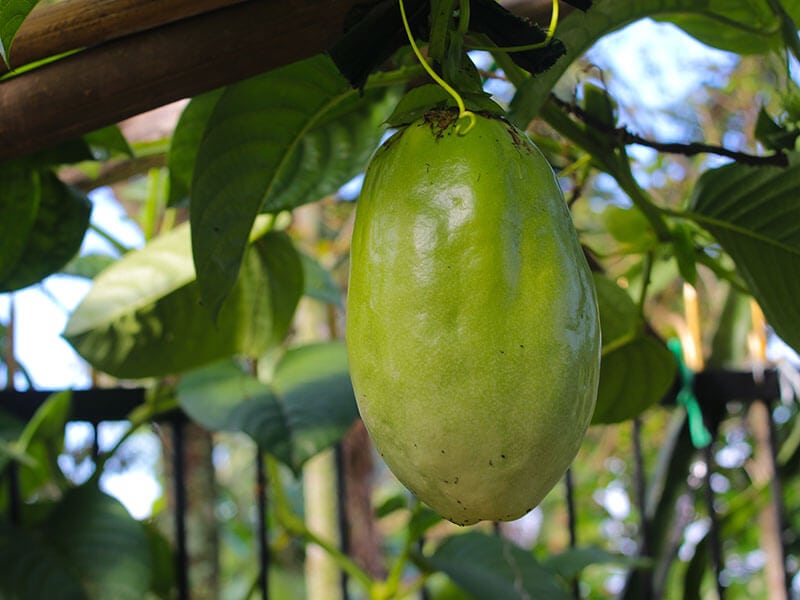
Granadillo has the scientific name Passiflora Quadrangularis, and it grows in abundance in the Dominican Republic. Since they belong to the same Passifloraceae species, the granadillo looks quite similar to the giant passion fruit.
The Dominican loves drinking fruity shakes and smoothies, and granadillo is a popular ingredient. Batida de Granadilla, or giant granadilla milkshake, is among the most popular shakes on this tropical island.
This fruit is also a common ingredient for the famous Dulce En Almíbar fruit syrup in the Dominican republic. Granadillo features a slightly sour and mildly sweet flavor with a recognizable aromatic scent.
A granadillo can range around 10 inches in size, and its texture is similar to the pear’s flesh. This fruit is very beneficial for people with hypertension and insomnia. It can help the muscles relax and enhance the growth of capillaries in the retina, which is beneficial for children.
However, you must chew carefully when eating granadillo. Though the tiny seeds in this fruit are edible, their small size can affect children’s digestive tract.
Nutrients: Granadillo is nutrient-packed, containing a lot of minerals like calcium, iron, sodium, phosphorus, and potassium. It is also rich in vitamins and carbohydrates with high protein content.
Season: The granadillo trees will bear fruit around 6 to 9 months after planting. The ideal time for harvesting is between November to January for the summer crop and between June and July for the winter crop.
How to eat: The ripe giant granadilla can be eaten fresh by cutting the thick skin in half with a sharp knife. However, it is commonly used for making milkshakes, fruity drinks, and desserts.
16. Annona Squamosa (Sugar Apple/Sweetsop)

Sugar apple or sweetsop is an edible fruit growing on the small Annona Squamosa that belongs to the Annonaceae family. People call it anón or mamón in the Dominican Republic. Sweepsop features a typical heart shape (about the size of an orange) and scaly green skin.
Its pulp possesses an airy and light color that delivers a beautiful aromatic scent, combined with a sugary and pleasant taste. Inside the white pulp are the black and shiny anón seeds that contain insecticidal properties.
For this reason, anón seeds are poisonous and deliver a bitter taste. It can be crushed into powder and used as an insecticide in many regions. Similar to the soursop, mamón juice is a popular beverage in the Dominican Republic.
Nutrients: Sugar apple is rich in carbohydrates, dietary fiber, protein, and potassium. It also carries a small proportion of fat and sodium with no cholesterol.
Season: The sugar apple seasons take place from mid-summer into fall in regions with hot and dry climates.
How to eat: You can peel the anón skin with your fingers and consume its pulp fresh. Remember not to eat its poisonous seeds. The pulp can also be filtered and mixed with ice cream, milk, or ice.
The following video is really essential if you want to know everything about Annona Squamosa.
17. Vinagrillo (Bilimbi)
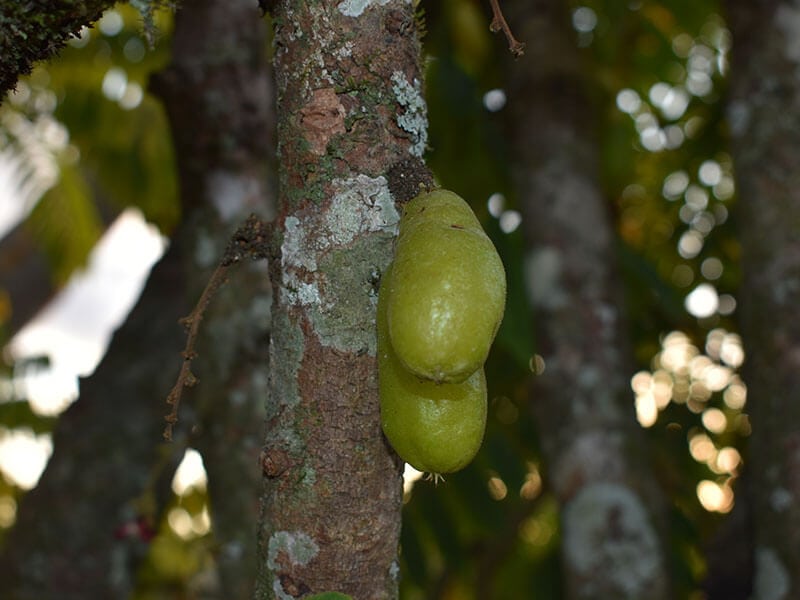
Vinagrillo, or bilimbi, is a native exotic fruit that originated in Indonesia but is also cultivated in the Dominican republic. The Dominican loves eating Vinagrillo raw or pickled by mixing it with vinegar in a recipe called Encurtido Y Agrio De Vinagrillo (Bilimbi pickle and vinegar).
Vinagrillo means “little vinegar,” which tells everything about this exotic fruit. In general, Vinagrillo features a powerful vinegary flavor. Since cooking at high heat will make this iconic sourness fade away, Vinagrillo is commonly eaten raw and fresh.
By pickling the Vinagrillo, people can reduce its acidic content and strengthen the vinegar taste. This fruit possesses some medical uses, which can treat rheumatism, diabetes, and skin problems. However, Vinagrillo is not suitable for people with kidney problems.
Nutrients: Vinagrilo is abundant in antioxidants, proteins, and vitamin C. It also contains anti-inflammatory elements such as terpenes and tannins.
Season: Vinagrillo fruits change from green to light yellow when they ripen, which happens in 50-60 days. However, Vinagrillo fruits are available every year due to their widespread cultivation.
How to eat: The best way to eat Vinagrillo is by pickling or eating it raw. It can act as a seasoning and preserves for many dishes, especially seafood and heavy meat. You can also make it into beverages or serve it raw with salt.
18. Guayaba (Guava Fruit)
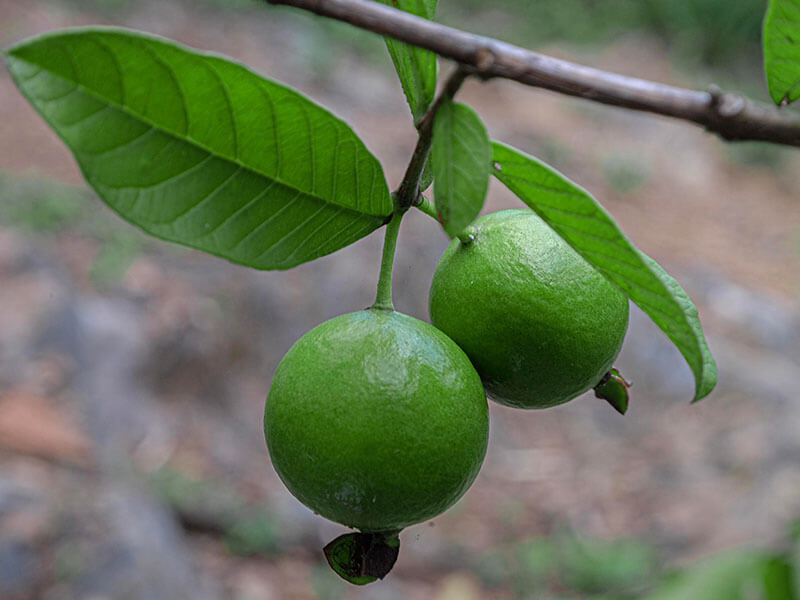
Guava is a popular fruit harvested in the tropical and subtropical regions. It is commonly known as the strawberry guava or the pineapple guava. The guava fruits possess a round or pear shape with a green or yellow color depending on their ripeness.
Its skin may be rough and bitter, but it will turn soft and sweet when the fruit gets ripe. The taste of guava is a bit unique and hard to describe. It is like a mixture of strawberry, pear, and mango.
This fruit usually features mild green skin when unripe. Local people often use guavas for various foods and beverages. The Dominican citizens love guava jam, which is their favorite filling for pastries and cakes.
Nutrients: Abundant in antioxidants, vitamin C, fiber, potassium, and folic acids.
Season: The guava trees can produce fruit all year round in tropical and subtropical countries. However, spring is the primary season of guava crops.
How to eat: Raw guava is edible, but you should sprinkle on some salt and remove the potential worms inside. The guava juice is also tasty and suitable for kids. It can be used to make guava jam, ice cream toppings, mint cocktails, or added to the salad.
You can also find the sweet treats, candies, and juices that involve guayaba to get a taste of this exotic fruit.
19. Cherimola/Cherimoya (Custard Apple)
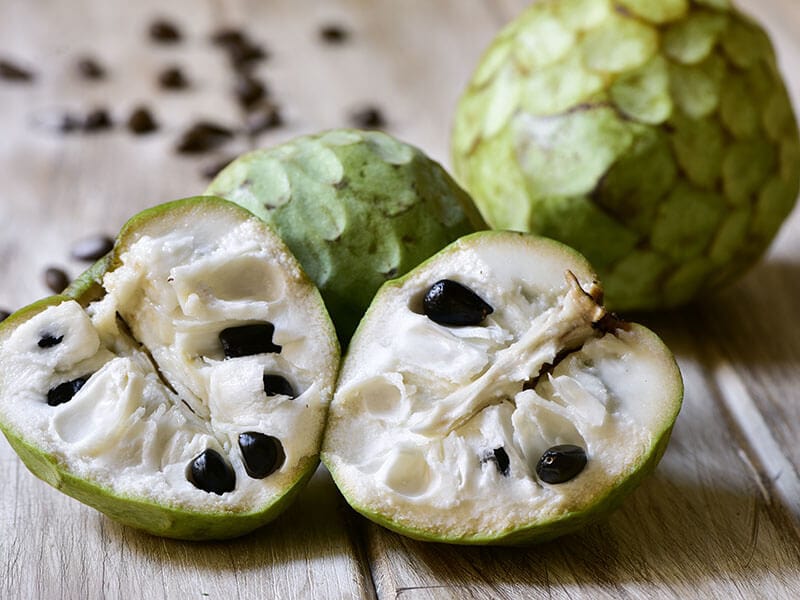
Another exotic fruit in the Dominican Republic is custard apple or cherimoya. This fruit has a lot of variations with diversified colors and skin textures. Overall, the cherimoya fruits have a heart shape, ranging between 7 and 12 centimeters in length.
Depending on its ripeness, the cherimoya flesh inside the hard green skin can be juicy and gives a fabulous aroma. It features a sweet and pleasant taste, similar to the mixture of watermelon and papaya.
Due to its high sugar content, cherimoya can satisfy any sweet tooth. It is a rich source of sustained energy. The natural sugar in this fruit is also safer to consume in high quantities since it doesn’t overaffect the insulin output of our bodies.
Nutrients: protein, minerals, fiber, calories, and mineral fats, along with healthy vitamins like vitamin B6 and vitamin C.
Season: The cherimoya flowering happens from April to May when the climate is hot. The trees bear fruit between August and November when there is high humidity.
How to eat: Only the ripened custard apple flesh is edible. You just need to slice the fruit in half and use the spoon to scoop the soft flesh. If its skin has turned purple or dark, cherimoya is no longer safe to eat.
The cherimola pulp can be used as an ingredient in sorbet or ice cream in many countries.
Custard apples are a very peculiar and special fruit. Find out why!
20. Guanabana (Soursop)
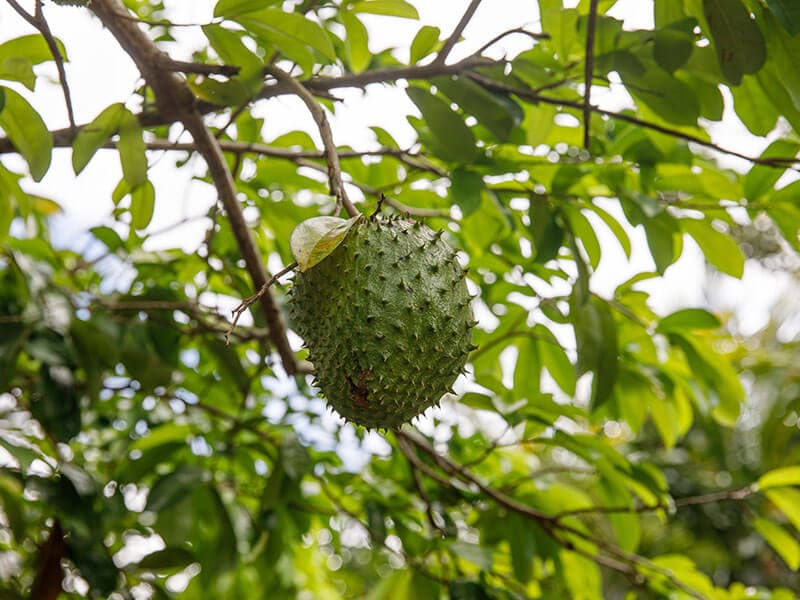
Guanabana or soursop is a large edible fruit that belongs to the apple family. It is a native fruit that grows in the tropical regions and Caribbean islands, including the Dominican Republic.
Inside guanabana’s prickly and dark green skin is white and fibrous flesh. Soursop features a very unique and yummy taste, which may be described as a combination of pineapple and mango.
A ripened guanabana can grow up to 20 centimeters in length and weighs up to 10 pounds. This fruit is used for making fruit nectar, juice, smoothies, and production of candies or sorbets.
Nutrients: Guanabana contains a lot of water, carbohydrates, protein, vitamin C, and some negligible fat.
Season: This fruit is available all year round, with the peak seasons from late fall to winter in the tropical regions.
How to eat: You can eat raw guanabana pulp, but remember to remove the seeds. This fruit can be served in juices, smoothies, desserts, or teas. There are many wines, ice creams, and nectars that involve the guanabana pulp.
21. Limoncello (Spanish Lime)

The Limoncillo, or Mamoncillo, usually grows in a cluster of more than 12 small limes, about 3 to 4 centimeters in diameter. Unlike regular limes, Limoncillo has a harder, leathery, and smooth green skin. It is native to tropical regions and South America.
In the Dominican Republic, you can easily find Limoncillo growing on the vendor trees in sunny spots. Its flesh commonly has a jelly-like texture with an orange or pale yellow color. The ripe Limoncillo delivers a sweet and acidic taste, while the unripe fruits are very sour.
Due to its sweetness, Limoncillo can be eaten right out of the skin. It can be used to make drinks and desserts or soaked with sugar and water to make alcoholic beverages. Eating Limoncillo is believed to soothe digestive problems and reduce hypertension.
Nutrients: Limoncillois are an abundant source of vitamins, phosphorus, fiber, and calcium.
Season: This fruit is available throughout the summer, with the peak seasons lasting between summer and fall.
How to eat: The best way to enjoy Limoncillo is to peel the skin and pop the whole fruit into your mouth, but don’t swallow its seed. You can sprinkle on some salt and chili to enhance its flavor.
22. Coconut

I’m sure that everyone must have tried this fruit more than once when visiting tropical beaches. Coconuts are just everywhere due to their high versatility and refreshing flavor. This fruit is simultaneously tasty and brings tremendous health benefits.
Coconuts originated in the Pacific but quickly spread to the Caribbean and tropical regions, including the Dominican Republic. You can easily spot thousands of coconut shells on the coastlines of this tropical island.
There’s no need to describe how delicious coconut fiber and juice taste. It features a mildly sweet, refreshing, and nutty flavor that everyone will love at the first taste. In addition, eating coconut products can aid the digestive system and balance your hormones.
The Dominican people also take advantage of coconut brown nuts, which can be used to produce coconut oil. In the Dominican culinary culture, coconut oil, flesh, and juice serve as a common refreshment and component for various rice dishes, sweets, or seafood.
Nutrients: Coconuts are very rich in saturated fat, fiber, calories, carbohydrates, and many other micronutrients.
Season: Both natural and cultivated coconuts are available all year round. A typical palm can bear around 100-200 coconuts annually.
How to eat: If you have a raw coconut, just penetrate a small hole in the shell and enjoy its juice first. Then crack open the coconut and use the spoon to scrape the meat. Coconut meat and juice even taste greater when they are frozen.
How are the juicy coconuts cultivated and harvested in the Dominican Republic? This video will show you.
23. Sandia (Watermelon)
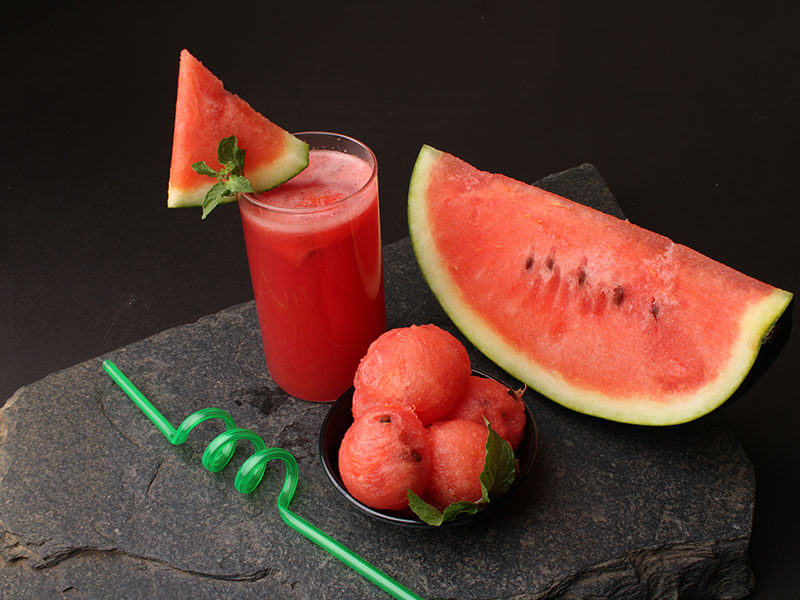
In one year, the Dominican Republic produces and exports thousands of tons of watermelon, with approximately 1,530 hectares for the cultivation of this fruit. There’s no need to further describe this gorgeous fruit’s flavor and appearance.
Watermelon, or Sandia in the Dominican Republic, is everyone’s favorite summer snack with low calories and a refreshing sweet taste. With an abundant source of natural sugar and antioxidants, this fruit can help your body detoxicate while satisfying your sweet tooth.
Nutrients: Besides the abundant calories, antioxidants, sugar, and fiber, watermelon is also a rich source of B vitamins and beneficial micronutrients.
Season: The earliest watermelon seasons start from May and end in September, with the peak in July and August.
How to eat: The easiest way is to eat the fresh watermelon by cutting the fruit into small slices. You can also blend the watermelon flesh with other veggies and fruits for smoothies or salads.
7 Dominican Fruits With Exotic Colors You Will Love
These fruits generally possess a dark and somewhat exotic appearance with brown, pink, red, or purple skins when they ripen. Their colors are an expression of love and vitality, which can attract you at first glance.
24. Uva de playa/Cocoloba (Sea Grape)
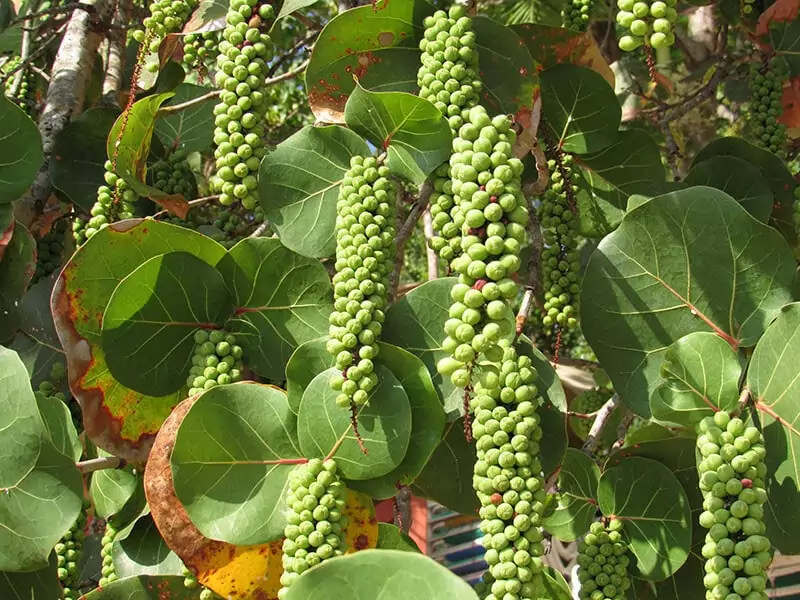
Uva de playa, commonly known as sea grape, is an indigenous fruit to the Caribbean countries that belong to the buckwheat family. As its name suggests, sea grape trees thrive in the coastal environment with a lot of strong wind, salt, and burning sunlight.
Therefore, you can find hardy and enduring sea grape trees growing on the Dominican shorelines. Contrary to many people’s beliefs that sea grape is poisonous, it is totally edible. However, its flavor is not similar to the common types of grapes you eat in America.
Sea grapes deliver a mildly sweet and acidic flavor when eaten raw. In addition, a sea grape contains a large seed and very little pulp content, so it is not the best snack for fruit lovers.
In addition, the sea grapefruits ripen individually, making them hard to harvest. For these reasons, the cultivation of sea grapes is not so common in the Dominican Republic. However, sea grapes trees’ benefits to the coastal environment are undeniable.
While the sea grape leaves provide humans with shade, its roots help prevent corrosion and stabilize the sand dunes on the beaches. Sea grapefruits are also food for various birds and mammals living near the coastal areas.
Nutrients: Seagrape contains an abundant amount of calcium, polyunsaturated fatty acids, and protein that help strengthen joints and bones. In addition, its rich proportions of vitamin C also prevent hypertension and diabetes.
Season: In the Dominican Republic and tropical countries, the sea grape trees only bear fruit between August and October. However, the fruits only get ripe and become edible in mid-September.
How to eat: You can consume the ripened sea grape, but it is commonly used to make juice, wine, or fermented alcoholic drinks.
25. Chinola (Passion Fruit)
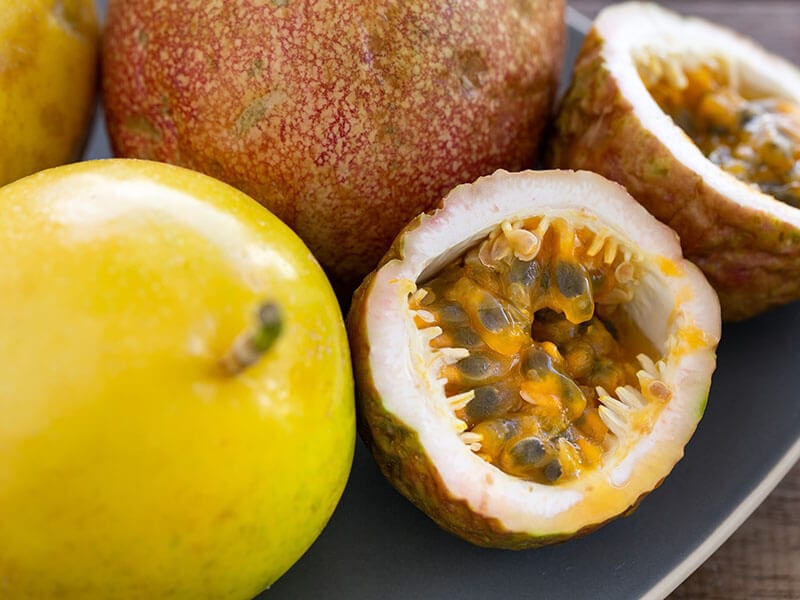
Chinola, or passion fruit, is a popular native fruit in the Dominican Republic. This fruit commonly has the size of a tennis ball, with the iconic yellow-green or purple skin. You can find a lot of crunchy seeds inside the jelly-like pulp, which are also edible.
Passion fruit can range from a sour and sweet flavor depending on its ripeness. The passion fruits harvested in the Dominican usually have yellow colors with a strong sweet taste. It is an abundant source of carbohydrates, antioxidants, healthy vitamins, and fibers.
Countless research has indicated that consuming passion fruits before bedtime gives you a more relaxing and satisfying sleep. Due to its rich source of carbohydrates, eating passion fruits is an ideal way to supply your body with energy for mild exercises.
Nutrients: Highly nutritious in calories, fiber, vitamin A and C, potassium, and iron.
Season: The passion fruits are available all year round in Hawaii. While in California, the passion fruit crops start from January through November.
How to eat: The pulp and passion fruit seeds are all edible. You can scoop its flesh and seeds into the bowl or serve right on the shell. It is also a common ingredient for fruit nectar, jam, passion fruit juice, or coulis. Cooking decadent desserts with passion fruits is also a brilliant idea.
If you prefer the Dominican way, slice the passion fruit in half and garnish the inside with sugar or honey. Then use a spoon and scoop the pulp along the seeds to serve.
It’s time to find out how the freshest and finest Chinola fruits are cultivated.
26. Cereza (Dominican Cherry)
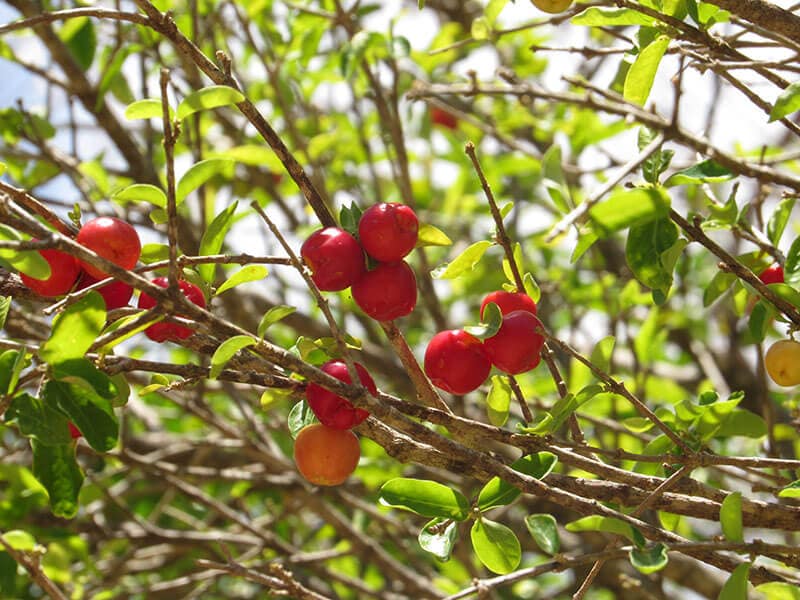
Cereza means “cherry” in Spanish. The Dominican cherries were introduced to this land by the Spanish settlers and hence became a popular cultivated fruit. This is not a common fruit that you can find every day as the Cereza season only lasts from June to July.
The Dominican cherries feature a typical sour taste with various skin colors, ranging from orange to yellow, pink, or red. This fruit is very light and small in size, which can fit easily in your hand.
Cereza is a famous component for making alcoholic juices, beverages, jams, and especially wine production. It gives the drinks a beautiful color and a pleasant sourness.
Nutrients: Cereza is rich in carbohydrates, calories, dietary fibers, and protein. The fruit is very healthy and doesn’t contain any saturated fat and cholesterol. It is also an abundant source of antioxidants, vitamin C, and diuretic properties.
Season: Cereza is pretty rare as it only grows between June and July.
How to eat: The ripe Cerezas can be eaten fresh, giving a similar but more acidic taste than regular cherries. It’s the fabulous ingredient for the best cocktails and wines, and it can also be used in jams.
27. Tamarindo (Tamarind)
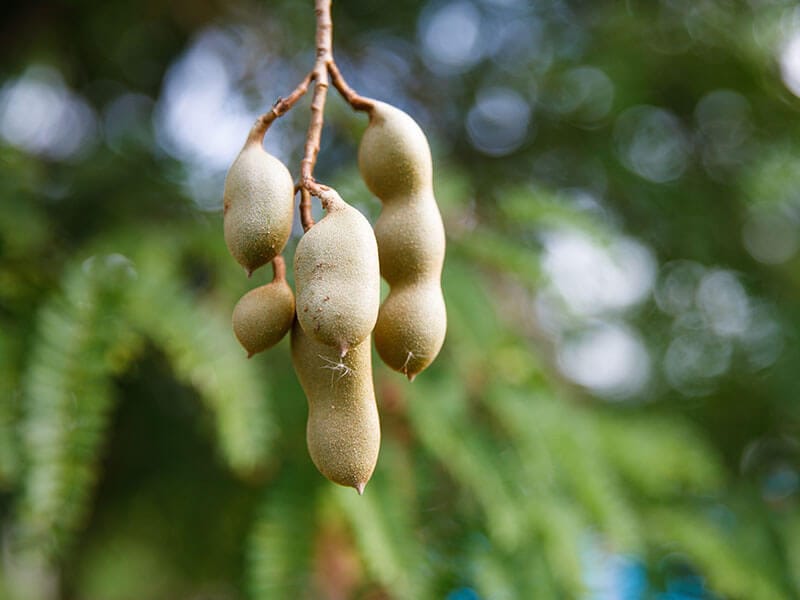
Another exotic fruit you may have tried more than once is tamarindo or tamarind. This fruit’s name derives from the “Arabic Tamar Hindi,” also known as the “Indian date” or “Dominican date” in the Dominican Republic.
The brown and pea-like fruit is a very common ingredient for cuisines in the Dominican Republic. Its flavor can range between sweet or sour, but most commonly, the combination of both flavors. You can think of tamarind as a tropical lemonade blended with caramel.
To serve tamarind, you need to remove the shell. Its pulp will get sweeter and less sour when the fruit ripens. In the Dominican Republic, tamarind pulp is blended with water to make the famous jugo de tamarindo beverage.
Nutrients: Rich in carbohydrates, sugar, vitamin B1, Vitamin B3, Potassium, Magnesium, and iron.
Season: The peak tamarind season starts from early spring to late fall.
How to eat: To eat raw tamarind, you need to crack open the pod, remove the strings inside, and chew around the pit. Tamarind can also be added to sauces, drinks, marinades, and desserts.
If you are still curious about the origins and tastes of tamarind, here is all you need!
28. Pitahaya (Dragon Fruit)

Pitahaya, or dragon fruit, is a prevalent tropical fruit in the Dominican Republic. It features iconic red skin and a seed-speckled white pulp. Though pitahaya originally grew in Central America and southern Mexia, the fruit has now been cultivated all around the world.
You can find two basic varieties of dragon fruit on the market with white and red pulp. There are also pitahayas with yellow skin and white flesh, called yellow dragon fruit. Regardless of the color, they all bring a pleasant and mildly sweet flavor.
Pitahaya is rich in antioxidants and fiber that can slow down the aging process and soothe the effects of chronic diseases. It also benefits our metabolic health and aids the digestive system.
Nutrients: Pitahaya is high in calories, protein, fat, carbohydrates, and other micronutrients.
Season: The main Pitahaya season is from June to September, with August and September as the peak months.
How to eat: Pitahaya gives the best taste when eaten raw. Serving the raw pitahaya is very simple. You just need to slice it in half using a sharp knife and use a spoon to eat. You can also peel off the skin and chop the pulp into small pieces to enjoy.
The pitahaya pulp can be frozen for making sweet treats like ice cream, jellies, yogurt, hams, candy, or cakes. It is also an ingredient in many preserves and wine products.
29. Morinda Citrifolia (Noni Fruit)
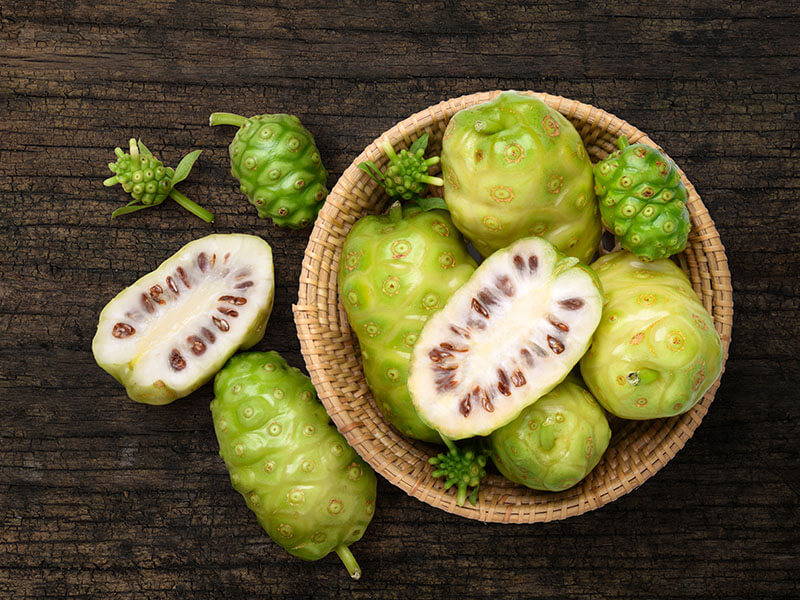
Morinda Citrifolia, or noni fruit, is indigenous to Australia and Southeast Asia, but it is also popular in tropical regions with warm climates like the Dominican Republic. It has dimpled skin with light green color with an unpleasant vomit-like odor.
For this reason, morinda citrifolia also has the nickname “vomit fruit” and is mainly consumed in times of famine. If you can’t put up with the smell, the tart and sour flavor of morinda citrifolia won’t be so tasty either.
When noni fruit gets ripe, its skin will slowly turn white and rot quickly. Although the bad smell will get more fetid on ripened fruits, their flesh will soften and enhance the cheesy flavor.
Nutrients: Abundant in calories, major nutrients like vitamin C, carbohydrates, calcium, protein, and other antioxidants.
Season: Morinda Citrifolia is harvested all year round in Hawaii, but fruit production may reduce in the winter month with unsuitable weather conditions.
How to eat: The best time to eat noni fruits is when their skins turn yellow. Unripe noni fruits are just too tough to chew. Their seeds are edible, but you can spit them out when chewing the slices of noni.
In addition, you can blend the whole noni fruit with cold water in a blender to make juice. Remember to discard the Noni seeds by pouring the juice through a sieve. As the juice tastes bitter, you can add sweeteners like honey or other fruit juices to enhance its flavor.
How does the noni fruit smell and taste like in real life? Check this guide to know more!
30. Avocado

Sometimes known as the tropical avocado, Dominican avocado is among the most nutritious and tasty tropical fruits. Avocados may come in various sizes and can weigh up to a few pounds. It features a smooth, glossy green or purple skin that will slowly darken when the fruits ripen.
The ripened avocado skin is so thin and soft that you can peel it off by hand. The avocado flesh features a creamy and thick texture, surrounding one big and firm avocado seed. They have grown in the Dominican Republic for many centuries as an agricultural focus.
The taste of avocado pulp is unique and impressive, with an unforgettable nutty and creamy flavor. The fans of butter will surely love eating this fruit. Besides the delicious taste, avocados are a superfood with many significant health benefits.
Nutrients: Avocados are dense in monounsaturated fat, fibers, minerals, and vitamins. In addition, they contain no cholesterol or unhealthy sugar.
Season: The best time to buy Avocados is between January and March, when they yield the best flavors. However, this fruit is available all year round in many regions, including America.
How to eat: The easiest way to enjoy avocado is to peel its skin and eat the raw pulp by sprinkling on some olive oil, salt, and pepper. You can also mix avocado flesh with salads, scrambled eggs, and other savory dishes.
Why is it healthy to consume avocado on a regular basis? Here is the answer for you!
What Are Your Favorite Dominican Fruits In This List?
There are so many reasons to love these Dominican fruits. They not only add more flavors and happiness to our lives but also bring tremendous health advantages. While many are available all year round, you can only find some exotic fruits in their peak seasons.
If you are fed up with the sugary treats and unhealthy desserts, these yummy and refreshing fruits are an ideal substitute. Their various colors, textures, scents, and flavors give you many options for diversifying your daily diet.
So, have you tried out all the fruits compiled in this list? Which one gives the best taste based on your personal experience? Please comment and share with me your thoughts. I would be so grateful if you could share and spread the love of fruits to others.
Thank you for reading!


Linda Dean
Expertise
Culinary Arts, Food Journalism, Global Cuisine, Exploration, Recipe Development, Cultural Food Studies, Culinary Travel and Storytelling
Education
Culinary Institute of America, Hyde Park, NY
Program: Associate in Culinary Arts
Focus: Developed a comprehensive understanding of global cuisines and essential cooking techniques. Engaged in intensive hands-on practice in both kitchens and real-world settings, guided by expert chefs. This program emphasized the application of culinary skills in professional environments, preparing students for a variety of roles in the culinary industry.
City, University of London, London, UK
Program: BA Journalism
Focus: Gained expertise in media studies with a strong foundation in reporting, editing, and communicating. While the program focuses broadly on journalism, the skills acquired apply to food journalism, including the ability to analyze and report on food culture and culinary trends effectively.
Linda Dean is an experienced chef and food writer who loves exploring flavors from around the world. Trained at the Culinary Institute of America, Linda has spent over ten years mastering the art of making dishes that truly represent different cultures. She also studied journalism at City, University of London, which helps her write engaging stories about these foods.
On heythattastesgood.com, Linda shares recipes that bring the world’s kitchens to her readers. She focuses on authentic tastes and the stories behind them, making it easy for anyone to try international cuisine at home.